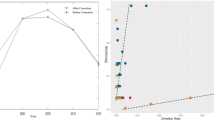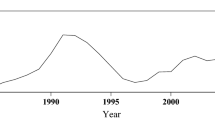Abstract
During the last decades immigration phenomenon reached a considerable importance, not only in research sector but also at public opinion level. Migration is a complex phenomenon demanding a system analysis which goes beyond demographic and economic considerations. The purpose of this study was to investigate the spatial structure of foreign presence in Italy in order to identify its geographical demarcation line among different interpretations. Traditional statistical analysis suggests different conventional indices allowing to quantify immigration phenomenon. Traditional indices, as Location Quotients and Segregation Index, have been compared to innovative indices including spatial statistics elements, as well as global and local indicators of spatial association. Such indicators have been created on the basis of available data for the case study, but also considering information which can be easily found in great part of national contexts.
Access this chapter
Tax calculation will be finalised at checkout
Purchases are for personal use only
Preview
Unable to display preview. Download preview PDF.
Similar content being viewed by others
References
Sjaastad, L.: The Costs and Returns of Human Migration. Journal of Political Economy 70, 80–89 (1962)
Walker, J.R.: Internal Migration, University of Wisconsin-Madison, http://www.ssc.wisc.edu/~walker/research/palgrave_6.pdf (Last access 8/11/2009)
Mincer, J.: Family Migration Decisions. Journal of Political Economy 86, 749–773 (1978)
Borruso, G.: Geographical Analysis of Foreign Immigration and Spatial Patterns in Urban Areas: Density Estimation and Spatial Segregation. In: Gervasi, O., Murgante, B., Laganà, A., Taniar, D., Mun, Y., Gavrilova, M.L. (eds.) ICCSA 2008, Part I. LNCS, vol. 5072, pp. 415–427. Springer, Heidelberg (2008)
Duncan, O.D., Duncan, B.: A Methodological Analysis of Segregation Indexes. American Sociological Review 20, 210–217 (1955)
ISTAT, Rapporto Annuale. La Situazione del Paese nel (2007)
Cristaldi, F.: Multiethnic Rome: toward residential segregation? Geojournal (58), 81–90 (2002)
Duncan, O.D., Duncan, B.: Residential Distribution and Occupational Stratification. American Journal of Sociology 60, 493–503 (1955)
Massey, D.S., Denton, N.A.: The dimensions of residential segregation. Social Forces 67, 281–315 (1988)
O’ Sullivan, D., Wong, D.W.S.: A Surface-Based Approach to Measuring Spatial Segregation. Geographical Analysis 39, 147–168 (2007)
Wong, D.W.S.: Spatial Dependency of Segregation Indices. The Canadian Geographer 41, 128–136 (1997)
Tobler, W.R.: A computer movie simulating urban growth in the Detroit region. Economic Geography 46(2), 234–240 (1970)
Moran, P.A.P.: The interpretation of statistical map. Journal the Royal Statistical society B, 243–251 (1948)
Anselin, L.: GeoDa 0.9 User’s Guide, Spatial Analysis Laboratory, Department of Agricultural and Consumer Economics and CSISS. University of Illinois, p. 125 (2003)
Anselin, L.: Spatial Econometrics: Methods and Models. Kluwer Academic, Boston (1988)
Anselin, L.: Local Indicators of Spatial Association-LISA. Geographical Analysis 27, 93–115 (1995)
O’ Sullivan, D., Unwin, D.J.: Geographic Information Analysis. John Wiley & Sons, Chichester (2003)
Badaloni, M., Vinci, E.: Contributi all’Analisi dell’Autocorrelazione Spaziale. Metron 46 (1988)
Author information
Authors and Affiliations
Editor information
Editors and Affiliations
Rights and permissions
Copyright information
© 2010 Springer-Verlag Berlin Heidelberg
About this paper
Cite this paper
Scardaccione, G., Scorza, F., Casas, G.L., Murgante, B. (2010). Spatial Autocorrelation Analysis for the Evaluation of Migration Flows: The Italian Case. In: Taniar, D., Gervasi, O., Murgante, B., Pardede, E., Apduhan, B.O. (eds) Computational Science and Its Applications – ICCSA 2010. ICCSA 2010. Lecture Notes in Computer Science, vol 6016. Springer, Berlin, Heidelberg. https://doi.org/10.1007/978-3-642-12156-2_5
Download citation
DOI: https://doi.org/10.1007/978-3-642-12156-2_5
Publisher Name: Springer, Berlin, Heidelberg
Print ISBN: 978-3-642-12155-5
Online ISBN: 978-3-642-12156-2
eBook Packages: Computer ScienceComputer Science (R0)




